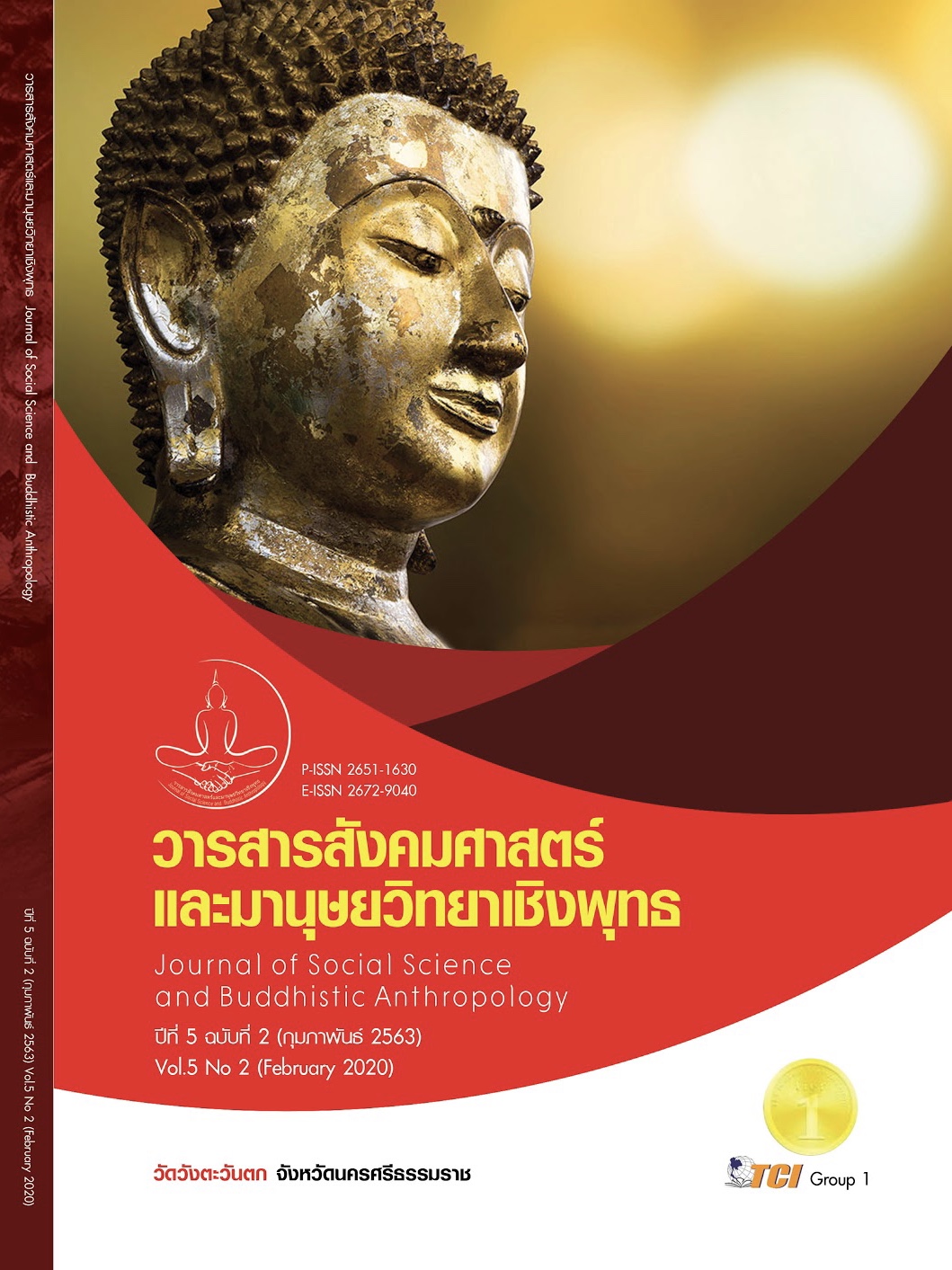A GUIDELINES FOR A BUDDHIST INTEGRATED ASSOCIATION OF FRIENDS FOR THAI CHILDREN AND YOUTH IN THE SOCIAL MEDIA
Keywords:
Association, Thai Childen And Youth, Social Media, Buddhist IntegrationAbstract
This qualitative research aims to 1) study the current situation of association with friends for Thai children and youth in the social media, 2) analyse the Theravada Buddhist doctrines concerning association and interaction with people and 3) propose the way to association with friends for Thai children and youth in social media. The thesis relied on documentary and in-depth interviews and focus group discussions. There were 20 key informants for the interviews and 10 for the discussions, all of which had been sampled via purposive sampling. In analysing qualitative data, the thesis used content analysis.
The results of this research shows that a guidelines for a Buddhist integrated association of friends for Thai children and youth in the social media can be summarized in the LOVE Model (LOVE stands for Learning from Others by being Vigilant through Experience.): categorised into 2 factors, external factor (influence of the others) which is hearing or learning from others. Others means all people that we have interacted with them. They must perform their responsibility duties in accordance with interaction rules described in Disa 6 principles. Then internal factor (Yonisomanasikara) which is critical thinking based on information given from external factor plus own empirical experience would result in thorough determined all aspects during critical thinking. Practicing this guidelines for association will enhance the process of critical thinking. Therefore child and youth will be immune against counter problems resulted in reducing risk from online threat.
References
กองกิจการเด็กและเยาวชน. (2561). การรู้เท่าทันสื่อออนไลน์ของเด็กและเยาวชน. เรียกใช้เมื่อ 10 สิงหาคม 2561 จาก https://www.dcy..go.th/web
ดวงรัตน์ โกยกิจเจริญ. (2558). ผลกระทบจาการใช้เครือข่ายสังคมออนไลน์ของนักเรียน นักศึกษาในจังหวัดภูเก็ต. วารสารวิชาการมหาวิทยาลัยราชภัฏภูเก็ต, 11(1), 157-186.
ทัศนีย์ เจนวิถีสุข. (2553). การฟื้นตัวจากวิกฤติสิ่งแวดล้อมตามมุมมองของพระพุทธศาสนา รวมบทความประชุมวิชาการทางพระพุทธศาสนานานาชาติ ครั้งที่ 7. กรุงเทพมหานคร: มหาจุฬาลงกรณราชวิทยาลัย.
นพมาศ ธีรเวคิน. (2542). จิตวิทยาสังคมกับชีวิต. (พิมพ์ครั้งที่ 3). กรุงเทพมหานคร: มหาวิทยาลัยธรรมศาสตร์.
นรวีร์ โชติวรานนท์. (2557). การหลงตนเอง: ศิลปะสื่อดิจิทัลสะท้อนความจริง และมายาบนสื่อสังคมออนไลน์. ใน วิทยานิพนธ์ศิลปะมหาบัณฑิต สาขาวิชาทัศนศิลปศึกษา. มหาวิทยาลัยศิลปากร.
ปวีณา หงสกุล. (23 ธันวาคม 2562). เด็กและเยาวชนไทยกับภัยออนไลน์. (ปารินันท์ ปางทิพย์อำไพ, ผู้สัมภาษณ์)
แผนพัฒนาเศรษฐกิจและสังคมแห่งชาติ ฉบับที่ 12. (2559). ราชกิจจานุเบกษา เล่ม 133 ตอนที่ 115 ก หน้า 1 (30 ธันวาคม 2559).
พระพรหมคุณาภรณ์ (ป.อ.ปยุตฺโต). (2557). พุทธธรรม ฉบับปรับขยาย. (พิมพ์ครั้งที่ 39). กรุงเทพมหานคร: มหาวิทยาลัยมหาจุฬาลงกรณราชวิทยาลัย.
พระมหาทวี มหาปญฺโญ และคณะ. (2557). การใช้ชีวิตในสังคมออนไลน์ตามหลักพุทธวิธี. ใน รายงานวิจัย. สถาบันวิจัยพุทธศาสตร์ มหาจุฬาลงกรณราชวิทยาลัย.
มูลนิธิอินเทอร์เน็ตร่วมพัฒนาไทย. (2562). รายงานการวิเคราะห์ข้อมูลสถานการณ์เด็กกับภัยออนไลน์ ประจำปี 2562. เรียกใช้เมื่อ 30 มกราคม 2563 จาก https://www.dcy. go.th/webnew/uploadchild/nwk/download/file_th_20191908150537_1.pdf
วิไลภรณ์ จิรวัฒนเศรษฐ์. (2559). เด็กยุคดิจิทัลภายใต้สังคมแห่งสื่อออนไลน์และการเรียนรู้ทางสังคม. วารสารอนาคตวิทยาทางการศึกษา, 1(1), 1-12.
ศรีเรือน แก้วกังวาน. (2551). ทฤษฎีจิตวิทยาบุคลิกภาพ. (พิมพ์ครั้งที่ 15). กรุงเทพมหานคร: สำนักพิมพ์หมอชาวบ้าน.
ศักดิ์ไทย สุรกิจบวร. (2546). จิตวิทยาสังคม ทฤษฎีและปฏิบัติการ. นครปฐม: สถาบันราชภัฏนครปฐม.
สำนักงานปลัดกระทรวงศึกษาธิการ. (2560). นโยบายไทยแลนด์ 4.0 มุ่งเน้นการขับเคลื่อนเศรษฐกิจแบบใหม่ . กรุงเทพมหานคร: สำนักงานปลัดกระทรวงศึกษาธิการ.
สุทธิพร นิราพาธ. (2557). ความสัมพันธ์ระหว่างการเล่นเกมคอมพิวเตอร์กับผลสัมฤทธิ์ ทางการเรียน และพฤติกรรมก้าวร้าวของนักเรียนชั้นมัธยมศึกษาตอนปลาย. ใน วิทยานิพนธ์ศึกษาศาสตรมหาบัณฑิต. มหาวิทยาลัยเชียงใหม่.
เสาวภาคย์ แหลมเพ็ชร. (2559). พฤติกรรมและผลกระทบจากการใช้เครือข่ายสังคมออนไลน์ของนักเรียนระดับชั้นมัธยมศึกษาตอนปลายในจังหวัดนนทบุรี. สุทธิปริทัศน์, 30(93), 116-130.








